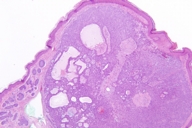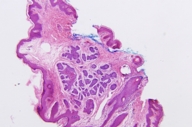Acrochordon-like basal cell carcinomas in patients with basal cell nevus syndrome
Published Web Location
https://doi.org/10.5070/D30039g7k0Main Content
Acrochordon-like basal cell carcinomas in patients with basal cell nevus syndrome
David N Lortscher1, Roberta D Sengelmann2, Shawn B Allen3
Dermatology Online Journal 13 (2): 21
1. Washington University School of Medicine St. Louis, MO. lortschd@wustl.edu 2. Department of Medicine, Division of Dermatology,
Washington University School of Medicine, St. Louis, MO 3. Colorado Permanente Medical Group, Lafayette, COAbstract
Basal cell nevus syndrome is an autosomal dominant disorder characterized by multiple basal cell carcinomas, along with numerous other documented clinical features. Acrochordons (or skin tags) are common benign neoplasms that are appropriately left untreated in most patients. We describe two patients with known BCNS who were found to have multiple BCCs that clinically resembled acrochordons. Our findings support the biopsy of acrochordon-like growths in patients with basal cell nevus syndrome to rule out basal cell carcinoma.
Basal cell nevus syndrome (BCNS or Gorlin syndrome) is an autosomal dominant disorder usually characterized by the early appearance of multiple basal cell carcinomas (BCCs), as well as by other variable clinical features such as odontogenic keratocysts, palmoplantar pits, calcification of the falx cerebri, and a coarse facies [1, 2].
An acrochordon (skin tag or fibroepithelial polyp) is a small, soft, usually pedunculated outgrowth of epidermal and dermal tissue most commonly seen in adults on areas of friction such as the neck, eyelid, axilla, and groin. In clinical practice acrochordons are usually not treated, and it has been written that in most instances they need not be submitted for microscopic examination [3].
Clinical synopsis
Patient 1
A 46-year-old woman with known BCNS was referred to our dermatologic surgery center for Mohs excision of BCCs of the scalp, glabella, and mandible. On the day of surgery, a full body exam revealed five additional suspicious lesions. Two of the lesions were pearly, telangiectatic, pedunculated papules of 2 and 4 mm, respectively, in her right antecubital fossa (Fig. 1). The other three were approximately 1 mm, skin-colored, pedunculated papules on the left side of the patient's neck (Fig. 2).
These neoplasms were snip-excised utilizing forceps and iris scissors, and the base of each lesion was gently cauterized. Histopathological examination showed both of the antecubital lesions—as well as two of the three neck lesions—to be BCCs. The third neck lesion was a true acrochordon by histology.
Patient 2
 |  |
| Figure 3A | Figure 3B |
|---|---|
| Figure 3A. Five soft, minimally-hyperpigmented neoplasms on right axilla of 12-year-old girl. All were BCCs by histology. Figure 3B. Nodular BCC. 4x | |
 |
| Figure 3C |
|---|
| Nodular BCC with a reticulate pattern. 10x. |
A 12-year-old girl with a new diagnosis of BCNS was referred to our dermatologic surgery center for evaluation of pearly papules on her face, neck, chest, and back. A full body examination revealed nine additional papules in the bilateral axillae ranging in size from 1 mm to 4 mm. These lesions were soft, skin-colored to slightly hyperpigmented, and minimally pedunculated (Fig. 3). They were not telangiectatic or pearly in appearance. Two of the larger lesions were shave-excised and found to be BCCs. Based on the results of these two biopsies, the seven smaller lesions were also excised and found to be BCCs.
 |
| Figure 4C |
|---|
| Figure 4C. Typical nodular BCC showing peripheral palisading as well as clefting between the tumor and surrounding stroma. 4x, 10x. |
On follow-up exam the following month, approximately sixteen additional 1-2 mm growths were noted on the girl's neck, chest, back, and buttocks. These were skin-colored and inconspicuous (Fig. 4). Each was removed by snip- or shave excision, and—not surprisingly—the majority were BCCs by histology, although a few were acrochordons.
Discussion
Basal cell nevus syndrome is an autosomal dominant disorder usually characterized by early-onset and multiple basal cell carcinomas, along with other variable clinical features such as odontogenic keratocysts, palmoplantar pits, bifid ribs, calcification of the falx cerebri, medulloblastomas, hydrocephalus, mental retardation, spine abnormalities, cataracts, and a coarse facies [1, 2]. About 40 percent of cases represent new germline mutations [4], and a study in the north-west of England found the prevalence of BCNS to be 1 in 55,600 persons [5]. The disorder has been traced to a mutation on chromosome 9 in the PTCH gene (human homologue of the Drosophila "patched" gene) [6], which functions as a tumor suppressor in the hedgehog signaling network [7]. In addition to its role in the cell cycle, PTCH helps control embryogenesis and the development of normal tissue [8].
An acrochordon or skin tag is a benign outgrowth of epidermal and dermal tissue that is most commonly seen in adults on areas of friction such as the neck, eyelids, axillae, and groin. Acrochordons have a reported incidence of 46 percent in the general population [9], and a 1996 study found only 5 of 1335 (~0.4%) clinically diagnosed acrochordons to be malignant (4 BCCs and 1 squamous cell carcinoma in situ) [3]. Because of their high incidence and their low probability of malignancy, acrochordon-like lesions are appropriately left untreated in most patients.
We have reported the cases of two previously diagnosed BCNS patients—one adult and one child—with multiple acrochordon-like papules that proved histologically to be BCCs. These acrochordon-like BCCs had a variety of appearances as shown above, and many of them could have been mistaken for benign growths requiring no treatment. We performed snip- or shave-excisions with 1 to 2 mm margins followed by gentle electrocautery of the base as a quick and clinically effective removal method; no recurrence at the removal sites had been seen clinically as of 10 months post excision. We will continue to follow these patients every 3-4 months throughout their lifetime.
In light of these cases, we recommend the excisional biopsy or destruction of all acrochordon-like lesions on patients with a known history of BCNS. Additionally, we support the conclusion by Chiritescu and Maloney that acrochordon-like lesions found in young patients should be biopsied [10]. Acrochordons are distinctly uncommon in childhood [9], and the discovery of an acrochordon-like BCC in a child can lead to the early diagnosis of BCNS [10]. A patient suspected to have BCNS should follow a regimen of increased sun protection and should see a medical geneticist, in addition to receiving regular dermatologic care.
References
1. High A, Zedan W. Basal cell nevus syndrome. Curr Opin Onc. 2005;17(2):160-166.2. Diaz-Fernandez JM, Infante-Cossio P, Belmonte-Caro R, Ruiz-Laza L, Garcia-Perla-Garcia A, Gutierrez-Perez JL. Basal cell nevus syndrome: Presentation of six cases and literature review. Med Oral Patol Oral Cir Bucal. 2005;10Suppl:E57-66.
3. Eads TJ, Chuang TY, Fabre VC, Farmer ER, Hood AF. The utility of submitting fibroepithelial polyps for histological examination. Arch Dermatol. 1996;132(12):1459-62.
4. Gorlin RJ. Nevoid basal-cell carcinoma syndrome. Medicine 1987;66:98-113.
5. Evans DG, Ladusans EJ, Rimmer S, Burnell LD, Thakker N, Farndon PA. Complications of the naevoid basal cell carcinoma syndrome: results of a population based study. J Med Genet. 1993;30(6):460-464.
6. Hahn H, Wicking C, Zaphiropoulos PG, Gailani MR, Shanley S, Chidambaram A, et al. Mutations of the human homolog of Drosophila patched in the nevoid basal cell carcinoma syndrome. Cell. 1996;85:841-851.
7. Cohen MM Jr. Nevoid basal cell carcinoma syndrome: molecular biology and new hypotheses. Int J Oral Maxillofac Surg. 1999;28:216-223.
8. Cohen MM Jr. The hedgehog signaling network. Am J Med Gen. 2003;123A:5-28.
9. Banik R, Lubach D. Skin tags: localization and frequencies according to sex and age. Dermatologica. 1987;174(4):180-183.
10. Chiritescu E, Maloney ME. Acrochordons as a presenting sign of nevoid basal cell carcinoma syndrome. J Am Acad Dermatol. 2001;44:789-794.
© 2007 Dermatology Online Journal







